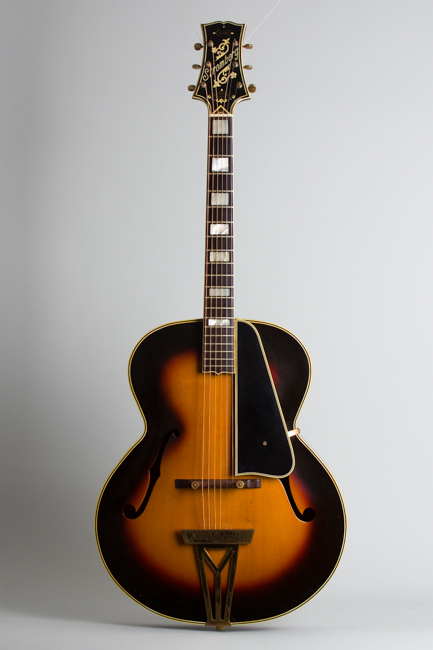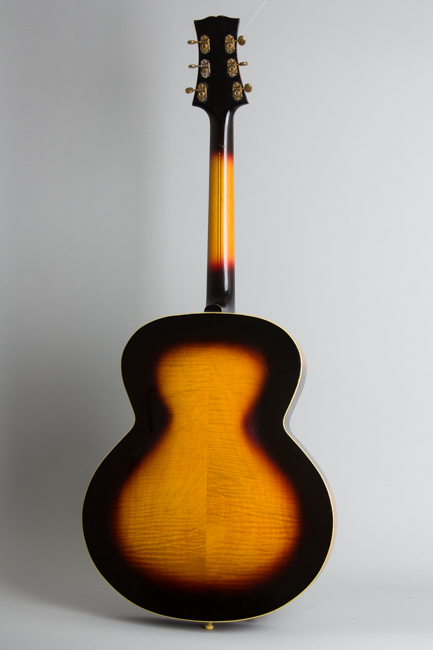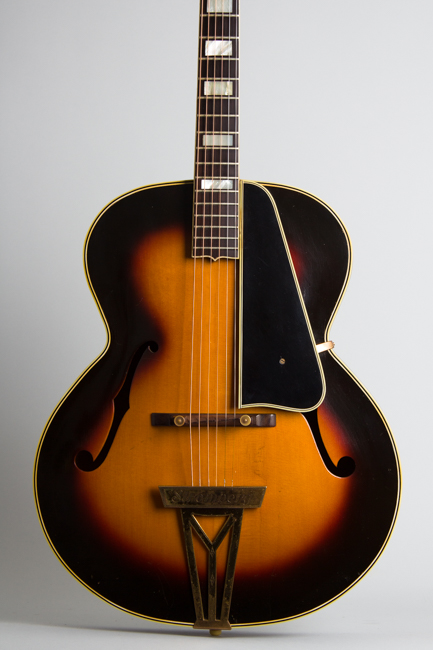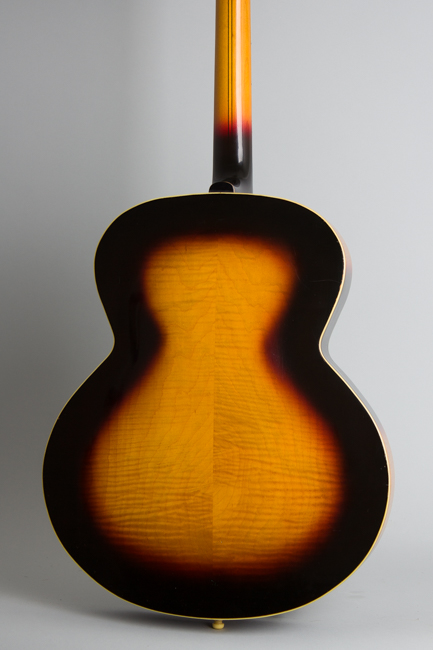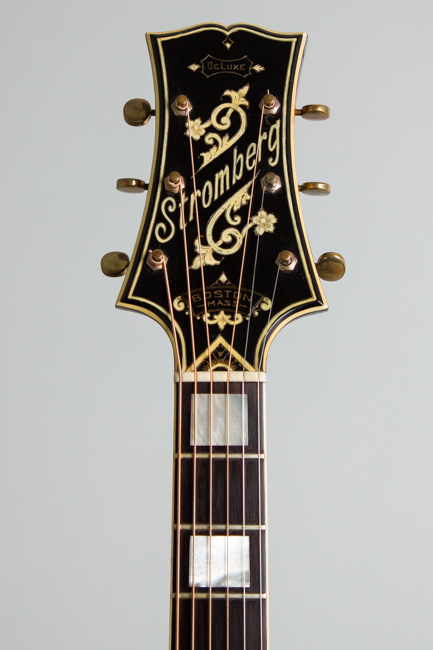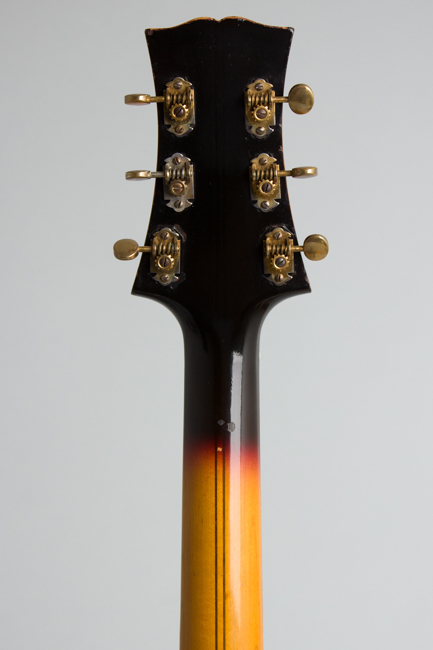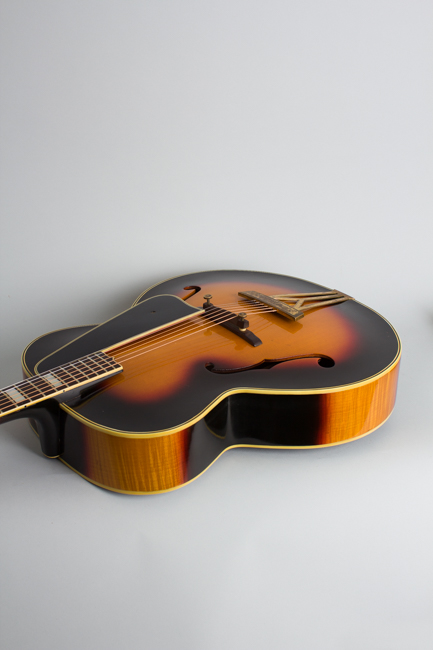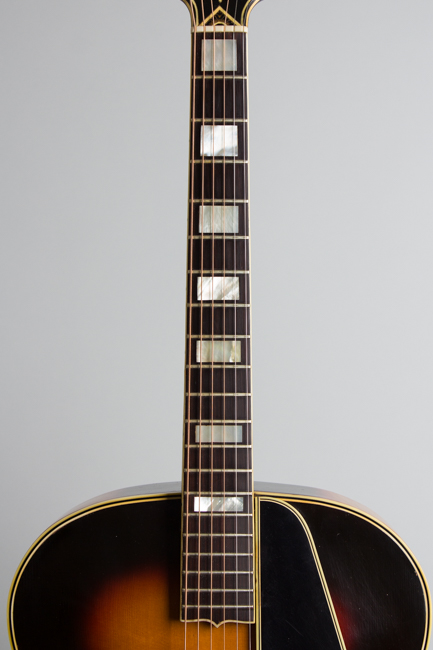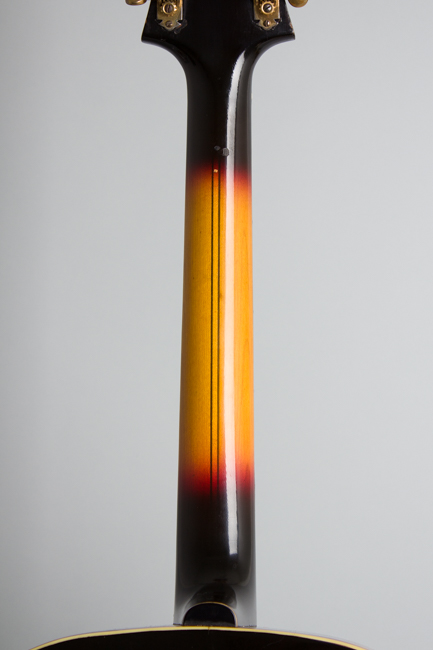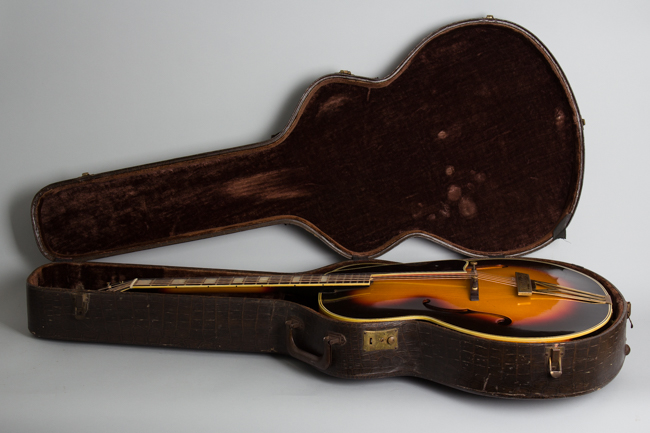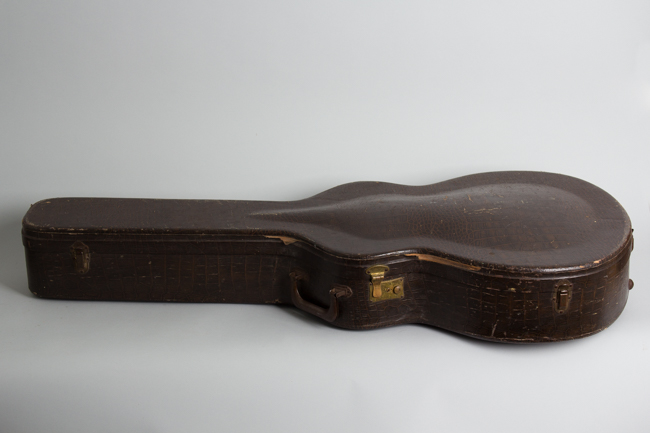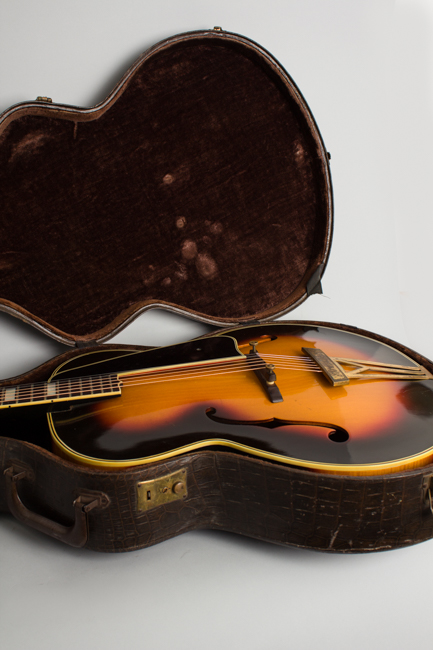Stromberg Deluxe Arch Top Acoustic Guitar (1941)
This item has been sold.
Item # 11070
Prices subject to change without notice.
Stromberg Deluxe Model Arch Top Acoustic Guitar (1941), made in Boston, Mass., serial # 514, sunburst lacquer finish, maple back and sides, spruce top, laminated maple neck with ebony fingerboard, original brown alligator hard shell case.
This very rare, lovely and stunningly well-preserved carved-top guitar is a product of the father-and-son team of Charles and Elmer Stromberg of Boston, enshrined as revered names in the annals of 20th century arch-top guitars. Elmer, the son, was the primary guitar artisan of the business; some of his handmade creations are considered among the greatest of all. In the 1940s his handmade Master 400 with a huge 19" wide body and single diagonal top brace was hailed as the most powerful of all acoustic big-band guitars, able to drive an orchestra better than any of its rivals. In the early 1940s both the Ellington and Basie Orchestras were riding on the rhythm of a Stromberg.
"A Modern Instrument For All requirements" was the headline on the Stromberg brochure. In 1940 the particular requirement at the top of the professional guitar pantheon was the orchestra arch top, the prestige market all guitar makers (even Martin, at the time) aimed for. The Strombergs built drums and banjos during the 1910s and '20s; by the early '30s their attentions turned to F-hole guitars but early efforts had heavily braced tops forced into an arch instead of carved, and laminate backs. These did not seriously rival Gibson, Epiphone or D'Angelico. The transition to high quality carved instruments with a single diagonal top brace took place around 1939 when Elmer began to create the guitars now considered the cream of the Stromberg crop.
This Deluxe model is Stromberg's L-5 equivalent, in the same class as the Epiphone Deluxe and the D'Angelico Excel. It is detailed in the Stromberg brochure with "This instrument is highly recommended by many of the leading guitarists throughout the nation" but of course that could be said of any of these models. What really distinguished Elmer's design is the unusual single-brace top design, which imparts an extra power and punch to the sound.
This guitar was built right as the Stromberg reputation was flowering; it bears serial number 514 and would date to late 1940 or more probably 1941. Freddie Guy's Stromberg Master 400 was serial number 499, known to have been acquired in 1940. The maple body is 17 1/2 inches wide, slightly larger than competing models. The top has heavy 3-ply binding, the back is single bound. The top is carved spruce, fairly thin with that one long trademark brace. The back and sides are maple, as is the 5-piece laminated neck. The bound fingerboard is ebony, with pearl block inlay. The finish is a bold dark-to-orange sunburst on all surfaces, cleanly applied but not particularly artfully blended.
The headstock of this guitar is where the Strombergs' detail artistry really shines. They had been building fancy banjos for many years; the delicate engraving on the laminated headstock face carries that legacy, a multi-laminate festival of cut-through Celluloid, dressed away at the edge to appear multi-bound, beautifully designed and flawlessly executed. The floral engraved pattern on the face sets off the diagonal "Stromberg" logo and the legends "Boston, Mass." and "Deluxe". The tuners are period Waverly openback machines; they appear to have been replaced at some point with flat-plate Klusons then re-instated.
The pickguard is a multi-bound celluloid piece with clean deco lines; the tailpiece is a large gold-plated affair with an engraved "Stromberg" logo on the crossbar and some attendant filigree. The carved rosewood bridge is Stromberg's unique top-adjusting design, which works well but feels obtrusive to some modern players who set their picking hand over the saddle. The neck has a comfortable round contour with just the slightest hint of a "V" in the dressed-away sides; it is slimmer than most Gibsons of the period if a bit chunkier than contemporary Epiphone practice.
Some Strombergs have a business card as a label; this one has a re-purposed mailing label, with "Stromberg 40 Hanover Street Boston Mass" across the top. Hand typed above is "Made By" and in the address box: "This guitar is guaranteed for a lifetime to the original purchaser, if used properly" along with the serial number. One wonders what a player would have had to do to have Charles and Elmer refuse them service due to "improper use"!
All Stromberg guitars are rare; older published estimates put the number made at around 600, but detailed analysis of existing instruments shows the serial numbers appear to start at 300, and so the total may be less than 350 guitars of all types ever built. Each is a unique gem. This 17 1/2" Deluxe is earlier to handle than the 19" Master 400 but a far superior instrument to the earlier 16" and 17" models that lack a carved top. This is the most deluxe 1941 Stromberg model offered that was NOT 19" wide, a size some players find awkward. The sound is very powerful but sweeter than many larger models; it has more richness to the tone than many Strombergs are credited with and is a worthy challenger to any pre-war L-5, Epiphone Deluxe or (dare we say it?) Excel. Many modern players have never even encountered a genuine 1940s Stromberg; we find this one enchanting and a pure pleasure to play.
Overall length is 42 1/2 in. (108 cm.), 17 1/2 in. (44.4 cm.) wide at lower bout, and 3 1/2 in. (8.9 cm.) in depth, measured at side of rim. Scale length is 24 3/4 in. (629 mm.). Width of nut is 1 11/16 in. (43 mm.).
This very rare guitar is simply stunningly well preserved for being over 80 years old, one of the nicest and most original archtops of this period we have seen regardless of maker. There are some small scuffs, scratches, dings and dents here and there but really the all-original finish still shines like Roosevelt had just been re-elected, for the second time! There are three feelable dinks into the back of the neck behind the first-second fret area, but little other wear to the playing surface. The top has some scuff marks near the tailpiece from a DeArmond control box, and a few random scratches.
Everything on the guitar appears complete and original. The tailpiece shows some plating corrosion and loss, as do the bridge wheels. The only alteration we can detect is what appear to be the original pattern tuners were re-installed in place of later post-war larger plate Klusons fitted at some point, with some telltale marks left behind. The original celluloid support bar under the pickguard was starting to outgass, so has been neatly (and invisibly) replaced. There is no other celluloid distress on the instrument except a few tight shrinkage cracks to the neck binding. The elaborate headstock on many Strombergs has deteriorated; this one remains unaffected by the years.
The frets appear original and in excellent shape; we believe the bone nut has been replaced. The neck is quite straight, the angle is excellent and this is a truly fine-playing guitar, practically a time capsule delivery from swing-era Boston to the 21st century. The sound is powerful but not strident; this 17 1/2" Stromberg belies their sometime reputation as simple rhythm drivers with a more complex and rich sound than they are often credited with. The original hard shell case has some external wear but is structurally fine. Excellent Condition.
This very rare, lovely and stunningly well-preserved carved-top guitar is a product of the father-and-son team of Charles and Elmer Stromberg of Boston, enshrined as revered names in the annals of 20th century arch-top guitars. Elmer, the son, was the primary guitar artisan of the business; some of his handmade creations are considered among the greatest of all. In the 1940s his handmade Master 400 with a huge 19" wide body and single diagonal top brace was hailed as the most powerful of all acoustic big-band guitars, able to drive an orchestra better than any of its rivals. In the early 1940s both the Ellington and Basie Orchestras were riding on the rhythm of a Stromberg.
"A Modern Instrument For All requirements" was the headline on the Stromberg brochure. In 1940 the particular requirement at the top of the professional guitar pantheon was the orchestra arch top, the prestige market all guitar makers (even Martin, at the time) aimed for. The Strombergs built drums and banjos during the 1910s and '20s; by the early '30s their attentions turned to F-hole guitars but early efforts had heavily braced tops forced into an arch instead of carved, and laminate backs. These did not seriously rival Gibson, Epiphone or D'Angelico. The transition to high quality carved instruments with a single diagonal top brace took place around 1939 when Elmer began to create the guitars now considered the cream of the Stromberg crop.
This Deluxe model is Stromberg's L-5 equivalent, in the same class as the Epiphone Deluxe and the D'Angelico Excel. It is detailed in the Stromberg brochure with "This instrument is highly recommended by many of the leading guitarists throughout the nation" but of course that could be said of any of these models. What really distinguished Elmer's design is the unusual single-brace top design, which imparts an extra power and punch to the sound.
This guitar was built right as the Stromberg reputation was flowering; it bears serial number 514 and would date to late 1940 or more probably 1941. Freddie Guy's Stromberg Master 400 was serial number 499, known to have been acquired in 1940. The maple body is 17 1/2 inches wide, slightly larger than competing models. The top has heavy 3-ply binding, the back is single bound. The top is carved spruce, fairly thin with that one long trademark brace. The back and sides are maple, as is the 5-piece laminated neck. The bound fingerboard is ebony, with pearl block inlay. The finish is a bold dark-to-orange sunburst on all surfaces, cleanly applied but not particularly artfully blended.
The headstock of this guitar is where the Strombergs' detail artistry really shines. They had been building fancy banjos for many years; the delicate engraving on the laminated headstock face carries that legacy, a multi-laminate festival of cut-through Celluloid, dressed away at the edge to appear multi-bound, beautifully designed and flawlessly executed. The floral engraved pattern on the face sets off the diagonal "Stromberg" logo and the legends "Boston, Mass." and "Deluxe". The tuners are period Waverly openback machines; they appear to have been replaced at some point with flat-plate Klusons then re-instated.
The pickguard is a multi-bound celluloid piece with clean deco lines; the tailpiece is a large gold-plated affair with an engraved "Stromberg" logo on the crossbar and some attendant filigree. The carved rosewood bridge is Stromberg's unique top-adjusting design, which works well but feels obtrusive to some modern players who set their picking hand over the saddle. The neck has a comfortable round contour with just the slightest hint of a "V" in the dressed-away sides; it is slimmer than most Gibsons of the period if a bit chunkier than contemporary Epiphone practice.
Some Strombergs have a business card as a label; this one has a re-purposed mailing label, with "Stromberg 40 Hanover Street Boston Mass" across the top. Hand typed above is "Made By" and in the address box: "This guitar is guaranteed for a lifetime to the original purchaser, if used properly" along with the serial number. One wonders what a player would have had to do to have Charles and Elmer refuse them service due to "improper use"!
All Stromberg guitars are rare; older published estimates put the number made at around 600, but detailed analysis of existing instruments shows the serial numbers appear to start at 300, and so the total may be less than 350 guitars of all types ever built. Each is a unique gem. This 17 1/2" Deluxe is earlier to handle than the 19" Master 400 but a far superior instrument to the earlier 16" and 17" models that lack a carved top. This is the most deluxe 1941 Stromberg model offered that was NOT 19" wide, a size some players find awkward. The sound is very powerful but sweeter than many larger models; it has more richness to the tone than many Strombergs are credited with and is a worthy challenger to any pre-war L-5, Epiphone Deluxe or (dare we say it?) Excel. Many modern players have never even encountered a genuine 1940s Stromberg; we find this one enchanting and a pure pleasure to play.
Overall length is 42 1/2 in. (108 cm.), 17 1/2 in. (44.4 cm.) wide at lower bout, and 3 1/2 in. (8.9 cm.) in depth, measured at side of rim. Scale length is 24 3/4 in. (629 mm.). Width of nut is 1 11/16 in. (43 mm.).
This very rare guitar is simply stunningly well preserved for being over 80 years old, one of the nicest and most original archtops of this period we have seen regardless of maker. There are some small scuffs, scratches, dings and dents here and there but really the all-original finish still shines like Roosevelt had just been re-elected, for the second time! There are three feelable dinks into the back of the neck behind the first-second fret area, but little other wear to the playing surface. The top has some scuff marks near the tailpiece from a DeArmond control box, and a few random scratches.
Everything on the guitar appears complete and original. The tailpiece shows some plating corrosion and loss, as do the bridge wheels. The only alteration we can detect is what appear to be the original pattern tuners were re-installed in place of later post-war larger plate Klusons fitted at some point, with some telltale marks left behind. The original celluloid support bar under the pickguard was starting to outgass, so has been neatly (and invisibly) replaced. There is no other celluloid distress on the instrument except a few tight shrinkage cracks to the neck binding. The elaborate headstock on many Strombergs has deteriorated; this one remains unaffected by the years.
The frets appear original and in excellent shape; we believe the bone nut has been replaced. The neck is quite straight, the angle is excellent and this is a truly fine-playing guitar, practically a time capsule delivery from swing-era Boston to the 21st century. The sound is powerful but not strident; this 17 1/2" Stromberg belies their sometime reputation as simple rhythm drivers with a more complex and rich sound than they are often credited with. The original hard shell case has some external wear but is structurally fine. Excellent Condition.
